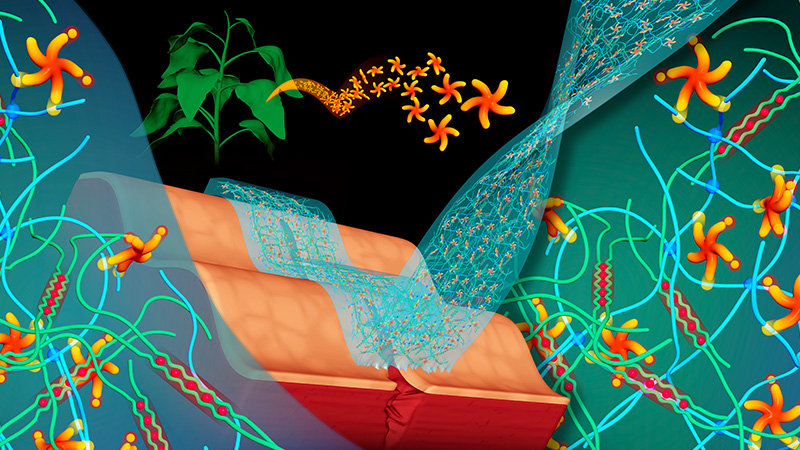Ultra-Strong, Elastic Bioadhesive with Tunable Multifunctionality

Molecular design of an ultra-strong, tissue-adhesive hydrogel patch with tunable multifunctionality and drug-delivery applications
Controlling bleeding and sealing a wound quickly to treat injured tissues are critical to saving the lives of trauma patients. Adhesives that can do both are in high demand, but many of them are difficult to apply and stick to wet tissue surfaces.
A UCLA research team led by Nasim Annabi, an assistant professor of chemical and biomolecular engineering at the UCLA Samueli School of Engineering, has developed a tough tissue-adhesive hydrogel patch that clings to a wound in wet tissue surfaces after pressing it gently for just a few seconds. Published in Bioactive Materials and featured on the journal’s November 2023 cover, the study details the mussel-inspired bioadhesive that can be applied with a gloved hand and is painless to detach with the addition of nontoxic chemical agents to the tissue-material interface. The adhesive supports the tissue’s physiological function over time under wet conditions.
Prior attempts of using bioadhesives had encountered problems including long clotting times, lack of adhesive strength, poor adhesion to wet tissue surfaces and low biocompatibility that limits parts of the body on which a bioadhesive could be used.
“Our approach enables us to tune the mechanical and adhesive properties of the hydrogel by manipulating building blocks of molecules,” said Nassim Annabi.
The UCLA researchers addressed these challenges by modifying a type of chemical compound found in seaweed named alginate, which helps the hydrogel bond strongly with the tissue surfaces. To establish robust adherence, the team then utilized tannic acid derived from plants that functions like the adhesive proteins secreted by mussels when they wish to attach themselves to underwater rocks. Along with improved strength and adhesion, the new bioadhesive is also more elastic, making it more compatible with different wound surfaces.
“Our approach enables us to tune the mechanical and adhesive properties of the hydrogel by manipulating building blocks of molecules,” said Annabi, who also holds a faculty appointment in the Department of Bioengineering and leads the Annabi Lab at UCLA Samueli. “This allows us to control various properties, including both antibacterial and antioxidant characteristics required to facilitate a wound’s healing process.
To demonstrate the hydrogel’s potential as an emergency medical bioadhesive, the team also published a study in Biomaterials that describes the new hemostatic patch’s ability to speed up the rate at which blood clots to help wounds close more quickly.
The patch has yet to enter clinical trials, but the team has demonstrated the patch’s abilities to heal wounds on small animals. The researchers have also explored this technology for drug-delivery applications. In one of its current projects, for example, the team embedded medications inside the patch and delivered the drugs to the eye to treat various ocular diseases, such as glaucoma and inflammation. The researchers also see potential to use the hydrogel bioadhesive for attaching medical sensors or other devices to the human body, helping better detect vital signs or diseases.
Both of these papers were funded by the National Institutes of Health. Other authors of the adhesive hydrogel paper are members of Annabi’s lab, including the first author and graduate student Yuting Zheng, who received the Daniel King Memorial Scholarship Fund Award by the Adhesion Society for her work on this project.
Zheng is also the first author of the hemostatic patch paper, joined by other authors who are members of Annabi’s lab — graduate student Steven Vo, and postdocs Mahsa Ghovvati and Avijit Baidya. Other authors are Kaavian Shariati, a student from the David Geffen School of Medicine at UCLA; and Taichiro Imahori and Naoki Kaneko, physicians with UCLA Health’s Department of Radiological Sciences. Another author is Nolan Origer, a former undergraduate student working in Annabi’s lab and now a graduate student at UC Irvine.
